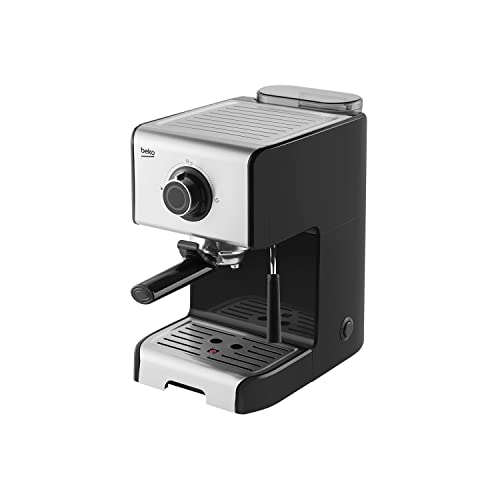Espresso Maker - A Must-Have For Home Baristas
Espresso is a dark, strong drink made by pushing hot coffee through finely ground coffee grounds that are tightly packed. It is the basis for many popular café drinks.
A skilled barista (also known as an espresso maker) controls a number of variables to make a great cup of espresso. These include the temperature of the water, its pressure, and how tightly the coffee is packed.
Origins
The espresso maker is a machine that pushes small amounts of boiling water at a near-to-simmering pressure through finely ground coffee beans. The resulting beverage is much stronger than drip coffee, is more concentrated, and served in smaller cups. This is an excellent choice for those who need a strong cup of coffee but want it quickly!

The first espresso machines were invented in the 19th century. At the time, coffee was a huge industry, but the process of making it took too long. Everyone was hungry for a quick cup!
espresso and filter coffee machine of Turin patented one of the first coffee machines in 1884. The name of the machine was "New steam machine, for the economical and instantaneous preparation of coffee beverages. Method A." Moriondo."
The Milanese makers Luigi Bezzerra and Desiderio Pavoni modified and improved this machine. They introduced the portafilter and multiple brewheads, as well in other innovations that are still in use with espresso makers today. Their machine was called Ideale and it impressed the crowds at the 1906 Milan Fair. Nine out of ten Italian homes have a Moka Pot.
Variations
Espresso is more concentrated in flavor than coffee. It is more flavorful than. It pairs well with milk and creates café favourites like lattes or cappuccinos. Its acrid flavor is evident in baked goods recipes, marinades and other dishes.
There are four types of espresso machines: semi-automatic, super-automatic, manual lever and. Each model uses a unique method of extracting the espresso.
A manual lever machine uses a mechanical piston that presses water through the ground. It's the ideal compromise between mechanical control and mechanized stability. It's still necessary grind, tamp and pull the shot yourself but there's more control over temperature and pressure.
Moka pots are yet another manual espresso maker that works similarly to a modern pump-driven espresso machine. Inside an airtight container, boiling water generates steam, which is then pushed through the bottom chamber, into a filter basket filled with ground coffee and into a metal filter, where it flows into the top cup. These machines are cheaper, however they can only create 1-1.5 bars of steam pressure. This is not enough to make espresso.
Ingredients
Espresso makers can aid baristas at home create popular cafe drinks like lattes and cappuccinos. You can also add flavored syrups or extracts to espresso shots for an indulgent drink like the espresso martini.
For a perfect cup of espresso you'll need high-end beans, fresh milk and sugar. To ensure an even extraction, look for coffee beans that have a specific espresso label. Grind them finely. You can try various roasts until you discover the one that suits your taste.
You'll require a burr mill to grind the beans to a uniform texture. The espresso machine has a portafilter, which holds the grounds, and the tamper is used to pack the coffee into a tightly packed.
You'll also need an espresso cup set as well as steamer to create the silky aerated milk that is the hallmark of espresso drinks. Some machines include steam wands that make the process easier. It is also essential to descale the machine. This involves running a solution of water and vinegar through the system.
Techniques
Espresso Brewing relies on the creation of pressure that allows for rapid extraction of intense flavors from finely-ground, dark-roast coffee packed tightly into a "puck." This method of brewing produces an intense coffee shot, known as espresso. When properly prepared espresso is a delicious crema (or dense foam) on top.
The majority of espresso makers utilize high-pressure water to force through finely ground coffee under high temperatures. This is different from the Moka Express, which uses heat to filter through coarsely grounded coffee. This creates an espresso-like beverage that can be mixed in milk or water to make other beverages, like cappuccinos or lattes.
The Moka Express is a cheap and simple device. Other espresso machines are more sophisticated, costly and offer a variety drinks. The most popular lever machines are Italian-designed, and use spring-loaded arm to dispense hot water from the cylinder into a portafilter. The barista is able to adjust variables like water temperature and grind size shot by shot to get the most optimal results. These machines helped bring espresso to greater prominence in Italy and Europe.
Equipment
A high-quality espresso machine should be able extract soluble and non-soluble solids out of finely ground, tightly packed coffee. This process is aided by controlled variables and pressure such as temperature and grind size. The flavor is also the result of a myriad of factors which include the beans used and how they are made.
There are several types of machines that can make espresso The most well-known is the semiautomatic machine. It utilizes an electric pump to agitate the water, and push it through the grounds. It also allows users to perform the grinding and tamping. These machines tend to be the least expensive, but they aren't as reliable as spring pistons or other manual designs.
The lever models that are more expensive feature a calibrated cylinder that does all the work. They're more tolerant than a spring piston machine but require some knowledge to use correctly. These machines require a lot more maintenance. You have to heat up the portafilter and then remove the portafilter and piston each time.
